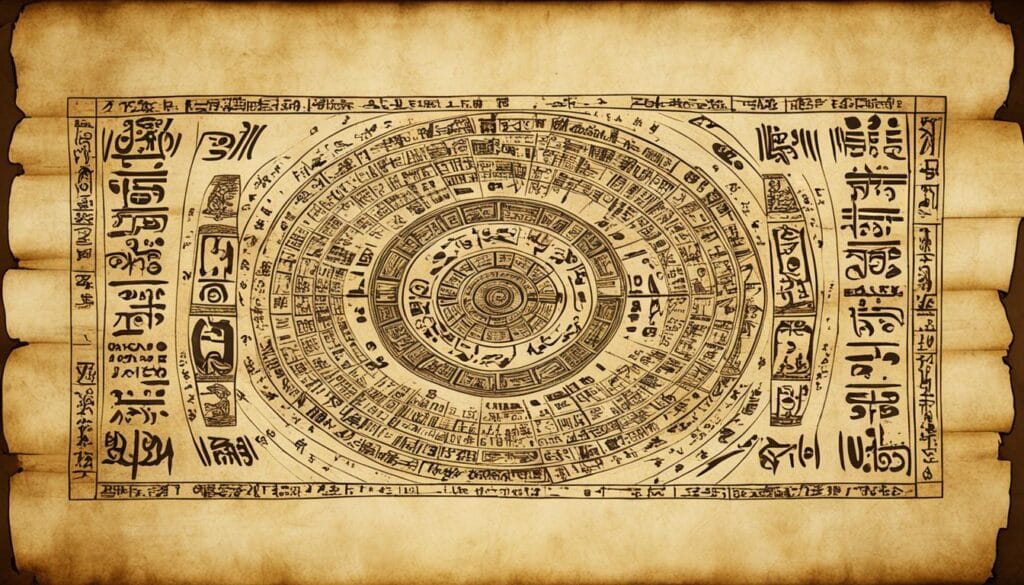Ancient Meditation History Tracing the Roots The Ancient History of Meditation

Meditation has been practiced for thousands of years, with its origins dating back to ancient times. Tracing the roots of meditation takes us on a journey through different cultures, traditions, and centuries of spiritual exploration.
Ancient Meditation History have left a lasting impact on philosophy, spirituality, and overall well-being. From the ancient Vedic tradition in India to the Zen meditation of Japan, meditation has evolved and spread across civilizations, adapting to different cultural contexts and influencing religious and spiritual practices.
Key Takeaways:
- Ancient meditation techniques have been practiced for thousands of years.
- The origins of meditation can be traced back to ancient civilizations.
- Meditation has influenced various religious traditions and philosophies.
- Ancient meditation techniques continue to be relevant and impactful in modern times.
- The history of meditation is rich and diverse, encompassing different cultures and traditions.
Historical Significance of Meditation in Ancient Civilizations
Meditation has a rich history, deeply rooted in ancient civilizations. From the Vedic tradition in India to Taoist practices in China and Buddhist traditions in India and neighboring countries, meditation played a crucial role in spiritual development.
Ancient cultures recognized the immense value of mindfulness practices, although they may have been referred to by different names. Egyptians and Greeks, for example, incorporated meditation into their religious rituals, seeing it as a way to connect with the divine and attain spiritual enlightenment.
Guidance on meditation techniques and its significance in spiritual growth can be found in ancient scriptures such as the Bhagavad Gita and the Yoga Sutras of Patanjali. These texts not only provide instructions for meditation but also emphasize the transformative power of this ancient practice.
| Ancient Civilization | Meditation Practices |
|---|---|
| Vedic Tradition (India) | Mantra chanting, breath control, and visualization |
| Taoist Practices (China) | Tai chi, qi gong, and internal alchemy |
| Buddhist Traditions (India, China, and neighboring countries) | Vipassana, Samatha, and Zazen meditation |
| Egyptian Civilization | Contemplation, ritualistic meditation, and dream incubation |
| Greek Civilization | Dianoetic meditation and philosophical contemplation |
These ancient mindfulness practices have paved the way for the modern understanding and application of meditation. Today, we continue to explore the depths of this transformative practice, drawing inspiration from the wisdom passed down through the ages.
Evolution of Meditation in Different Religious Traditions
Meditation has evolved and flourished within various religious traditions, playing a crucial role in spiritual development and self-realization. Let’s explore how meditation has been practiced and embraced in different cultures and religions throughout history.
Ancient Hindu scriptures, such as the Upanishads and the Bhagavad Gita, provide profound insights into the practice of meditation and its significance in spiritual growth. These scriptures offer detailed instructions on various meditation techniques, emphasizing the cultivation of inner peace, self-awareness, and connection with the divine.
Buddhism, another prominent religion, has its own rich meditation heritage. Buddhist meditation practices, such as Vipassana and Zen, place a strong emphasis on mindfulness and present-moment awareness. Practitioners are encouraged to observe their thoughts and sensations without judgment, cultivating a deep sense of clarity and insight.
In Jainism, meditation serves as a means of self-realization and liberation from the cycle of birth and death. Jain scriptures highlight the significance of meditation as a transformative practice that unveils the true nature of the self and fosters spiritual enlightenment.
Taoist meditation, rooted in Chinese philosophy, aims to cultivate energy and achieve harmony with nature. Taoist scriptures provide guidance on various meditation techniques, including breath control and visualization, that facilitate the alignment of the body, mind, and spirit to achieve a state of balance and tranquility.
These ancient traditions continue to exert a profound influence on contemporary meditation practices and philosophies. Modern practitioners often draw inspiration and insights from these traditions, incorporating their ancient wisdom into the development of new approaches and techniques.
Ancient Meditation Scriptures
| Religious Tradition | Ancient Meditation Scriptures |
|---|---|
| Hinduism | Upanishads, Bhagavad Gita |
| Buddhism | Pali Canon, Zen Teachings |
| Jainism | Āgamas, Tattvartha Sutra |
| Taoism | Tao Te Ching, Zhuangzi |
Spread of Meditation to the West
The practice of meditation has a long history rooted in ancient civilizations, but its influence has permeated Western culture in modern times. The West’s fascination with meditation can be traced back to the late 19th century, a period characterized by globalization and advancements in transportation and communication.
During this time, scholars and missionaries played a pivotal role in introducing Eastern philosophies, including meditation, to the Western world. These individuals brought back knowledge and teachings from Eastern cultures, sparking a growing interest in meditation among Westerners.
In the 20th century, meditation masters from the East made their way to the West, sharing their wisdom and practices with eager students. Westerners, inspired by their experiences, journeyed to Asian countries to study mindfulness and meditation under the guidance of these great masters.
One influential figure in the spread of mindfulness in the West is Jon Kabat-Zinn, who founded the Mindfulness-Based Stress Reduction (MBSR) program in 1979. This secular form of mindfulness gained significant popularity, helping to demystify meditation and making it accessible to a broader audience.
Mindfulness practices without religious overtones have gained widespread acceptance in the West, finding a place in various fields such as healthcare and psychology. These practices focus on enhancing well-being, reducing stress, and promoting self-awareness.
Western interest in meditation blossomed as scholars and missionaries introduced Eastern philosophies to the region, sparking a desire to explore mindfulness and cultivate a deeper understanding of oneself.
The growing interest in meditation in the West has led to its integration into various aspects of modern society. This integration is driven by a recognition of the immense benefits that meditation brings, including stress reduction, improved mental health, and overall well-being.
Western Interest in Meditation: A Transformative Journey
The journey of meditation in the West has been transformative, with its influence spreading far and wide. From its humble origins in ancient civilizations to its present-day popularity, meditation has become a powerful tool for personal growth and self-discovery in the Western world.
Explore the table below for a summarized overview of the modern history of meditation in the West:
| Year | Milestone |
|---|---|
| 19th Century | Introduction of Eastern philosophies to the West |
| 20th Century | Arrival of meditation masters from the East |
| 1979 | Jon Kabat-Zinn’s founding of the Mindfulness-Based Stress Reduction (MBSR) program |
| Present | Integration of mindfulness practices into various fields |
Benefits and Effects of Meditation
Regular meditation practice offers a multitude of benefits that positively impact both mental and physical health. Scientific research has highlighted the following advantages:
- Stress Reduction: Meditation has been proven to be an effective tool for reducing stress levels. By calming the mind and promoting relaxation, it helps individuals manage daily challenges with greater ease.
- Improved Mental Health: Engaging in regular meditation can have a positive impact on mental well-being. It has been shown to alleviate symptoms of anxiety and depression, enhance self-awareness, and cultivate a more positive outlook on life.
- Increased Focus and Attention: Meditation exercises the mind and trains it to sustain focus and attention. By practicing mindfulness, individuals become better equipped to concentrate on tasks, improve productivity, and enhance overall cognitive function.
Moreover, research has shed light on the effects of meditation on the brain. Studies have demonstrated:
Increased Cortical Thickness: Regular meditation has been associated with an increase in cortical thickness, indicating enhanced neural connectivity and improved cognitive function.
Meditation has also been found to positively impact physiological variables such as:
Heart Rate: Meditation can lower resting heart rate, promoting cardiovascular health.
Blood Pressure: Regular practice has been linked to reduced blood pressure levels, reducing the risk of hypertension and related illnesses.
Autonomic Function: Meditation has shown to modulate the autonomic nervous system, leading to improved overall body functioning.
The benefits of meditation have led to its integration into various therapeutic interventions, including mindfulness-based stress reduction programs. These programs have shown promising results in improving physical and psychological well-being.
Expert Insight:
“Meditation is a powerful practice that has profound effects on both our mental and physical well-being. By taking the time to cultivate mindfulness and stillness, individuals can experience reduced stress, improved focus, and enhanced overall health.” – Dr. Sarah Johnson, Clinical Psychologist
Cultural and Modern Relevance of Meditation
Meditation holds a significant cultural significance, deeply rooted in various religious traditions and rituals. From Hinduism to Buddhism and Jainism, meditation continues to play a central role in spiritual practices.
In addition to its religious and spiritual associations, meditation has gained considerable popularity in modern society. Surveys reveal that an increasing number of Americans have embraced meditation as a regular practice.
Moreover, meditation has been integrated into various fields, demonstrating its modern-day relevance. In healthcare, meditation is utilized as a powerful tool for stress reduction, promoting overall well-being. Educational settings incorporate meditation to enhance focus, self-exploration, and emotional well-being. Furthermore, the corporate world has recognized the benefits of meditation in reducing stress and improving productivity.
Individuals and organizations are actively promoting meditation as a means of achieving inner peace, personal growth, and spiritual development. The practice of meditation is embraced as a path towards mindfulness, self-awareness, and aligning with one’s deeper purpose.
Meditation has also found a place in secular mindfulness programs that are focused on stress reduction and enhancing the overall quality of life. By embracing meditation devoid of religious associations, these programs make the practice accessible and beneficial for individuals from all backgrounds.
The cultural and modern relevance of meditation is evident in its continued integration into different aspects of society. As more individuals recognize its benefits, meditation is poised to become an integral part of our collective well-being and personal growth.
The Future of Meditation
Meditation is a practice that continues to evolve as new techniques and approaches are developed, influenced by contemporary challenges and advancements in technology. As we look ahead to the future of meditation, we can anticipate exciting developments that will shape the way we engage with this ancient practice.
- Evolution of Meditation Practices: With ongoing research and exploration, meditation practices are evolving to meet the needs and interests of modern practitioners. Traditional techniques are being adapted and combined with other disciplines such as yoga, mindfulness, and cognitive therapy.
- Integration of Technology: Technology is playing a significant role in the future of meditation. Smartphone apps, virtual reality, and biofeedback devices are opening up new possibilities for widespread access and personalized practice. These tools provide guidance, tracking, and feedback to enhance the meditation experience.
- Potential Applications: Research on the effects of meditation is ongoing, and its potential applications are being explored in various fields. In healthcare, meditation is being integrated into treatment plans for stress reduction, pain management, and improving overall well-being. In education, meditation is being introduced to schools as a tool to enhance focus, attention, and emotional regulation. In sports and performance, meditation is being used to improve mental resilience and enhance performance.
- Increasing Popularity: As more people recognize the benefits of meditation, its popularity is expected to continue growing. The future will see meditation becoming more mainstream, with individuals, organizations, and even corporations integrating it into their daily lives and routines. This widespread adoption and acceptance will further propel the exploration and development of meditation practices.
As we move forward, the future of meditation holds great potential for enhancing our overall well-being, promoting a deeper understanding of ourselves, and facilitating personal growth. The integration of technology, continued research, and the increasing popularity of meditation will shape the evolution of this ancient practice in the years to come.
Conclusion
In summary, the Ancient Meditation History is a rich tapestry that spans thousands of years and encompasses a wide range of cultures and traditions. From its origins in ancient India to its spread across the globe, meditation has played a significant role in shaping spiritual and philosophical development.
In today’s modern world, meditation has gained widespread recognition for its numerous benefits. It has proven to be an effective tool for reducing stress, improving mental health, and enhancing overall well-being. As science continues to explore the potential applications of meditation, its future looks promising, with the possibility of further integration into various aspects of society.
Whether practiced for spiritual, mental, or physical reasons, meditation offers a pathway to inner peace and personal growth. As we continue to unlock the potential of this ancient practice, it is clear that meditation will continue to have a lasting impact on individuals and communities around the world.














